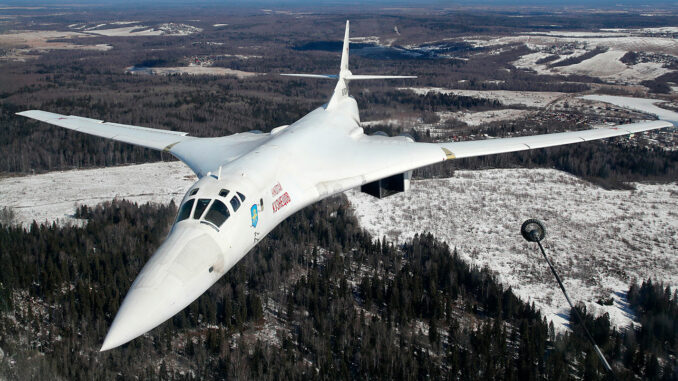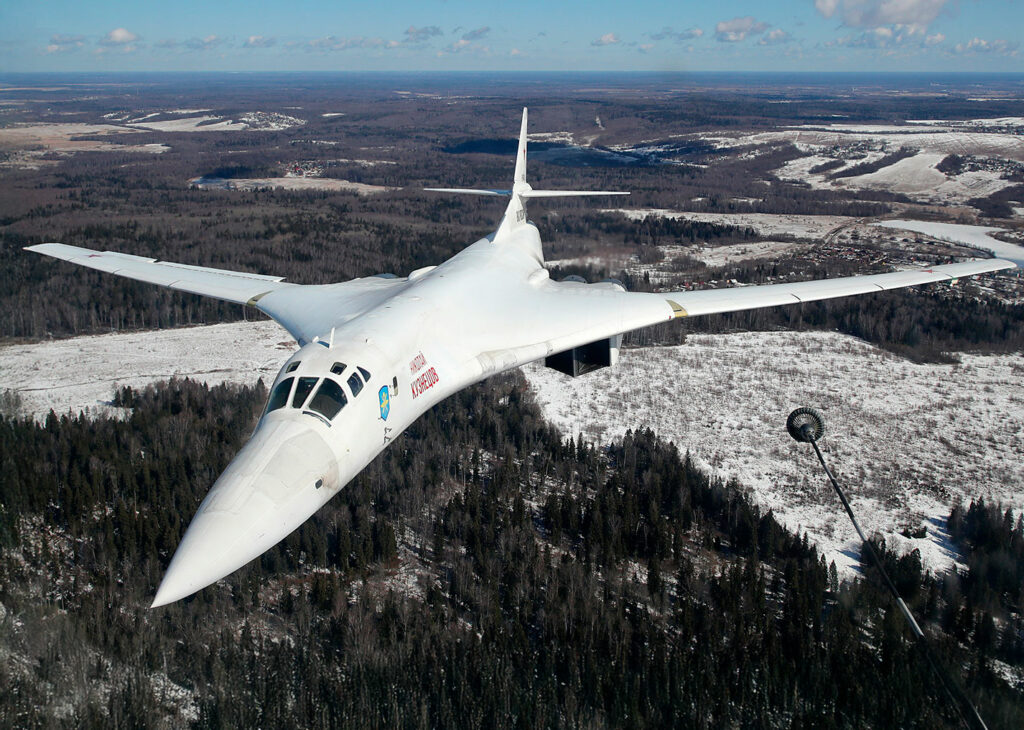
Russian Tu-160 strategic bombers conducted an 11-hour patrol over the Arctic Ocean—a show of force, strategic projection, and a game changer in modern air warfare.
In summary
One or more of these giants of Russian aviation, the Tupolev Tu-160s, recently completed an extended 11-hour mission over neutral waters in the Arctic Ocean, according to a statement from the Russian Ministry of Defense. This extended Arctic patrol demonstrates Russia’s desire to maintain a strategic presence in an increasingly contested region. Capable of carrying conventional or nuclear cruise missiles, the Tu-160—whether modernized or in its recent “M” version—remains a pillar of Russian power projection. But this mission also raises questions: logistical support in the polar region, vulnerability to modern threats, and the relevance of strategic bombers in the context of asymmetric warfare.
The operation: a long-haul flight over the Arctic
On November 25, 2025, the Russian Ministry of Defense announced that a unit of Tu-160 strategic bombers had completed a planned flight over neutral waters in the Arctic Ocean, lasting more than 11 hours.
According to the statement, this mission is part of the regular operations of the Long Range Aviation, which patrols—according to Moscow—in accordance with international air law.
According to open sources, this flight comes after the inauguration of the new modernized Tu-160s (the “Tu-160M” version), equipped with updated avionics systems, more powerful engines, and increased range and relative stealth capabilities.
The Tu-160 is one of the fastest strategic bombers in the world—capable of exceeding Mach 2 at altitude—and can carry up to 45 tons of weapons, cruise missiles, or strategic bombs.
The combination of its longevity, in-flight refueling capability, and modernization make the Tu-160 a key vehicle for Russia’s global projection.
Moscow’s motives: why the Arctic today?
The Tu-160’s Arctic patrol serves several strategic objectives.
Asserting Russia’s presence in a disputed area
The Arctic has become a crucial theater. With melting ice, new sea routes, natural resources, and geopolitical ambitions, the region is a focus of major interests. By deploying a strategic bomber there, Moscow is sending a clear message—Russia is asserting its ability to operate in the most extreme conditions and to threaten distant targets from the Far North.
This show of force is intended to deter any outside actors—Arctic states, military alliances, extra-regional powers—and to assert Russian sovereignty.
Maintaining the credibility of Russia’s deterrent force
The Tu-160 is one of the pillars of Russia’s nuclear triad, alongside land-based missiles and submarines. By continuing to use it in regular and visible missions, Russia seeks to maintain the credibility of its deterrence by showing that it retains operational, modern, and ready-to-use strategic air capabilities.
In addition, the modernized “M” version offers navigation systems and very long-range cruise missile launch capabilities, which reinforces the value of these Arctic patrols as a demonstration of power.
Testing logistics and projection in extreme conditions
The Arctic imposes unique constraints: intense cold, isolated airfields, lack of infrastructure, and difficult air navigation. An 11-hour flight requires in-flight refueling or the ability to land at a suitable base.
By operating at high latitudes, Russia validates its procedures, trains its crews for long-distance flights in polar environments, and prepares its bombers for risky missions, potentially in hostile or contested areas.

The strategic impact: what this type of patrol changes
Renewed pressure on NATO countries and the United States
A Tu-160 flying over the Arctic can threaten launch pads from the north—Alaska, Canada, and other nearby areas. Even if these flights remain in neutral waters, their mere existence requires monitoring approaches, maintaining constant radar surveillance, and mobilizing air defense capabilities.
For NATO allies, this posture requires a review of northern coverage, operational readiness, and long-range missile detection capabilities.
A redefinition of the importance of strategic bombers
In a context of asymmetric conflict, hybrid warfare, and precision weapons, strategic bombers are sometimes considered relics of the Cold War. But the renewed use of the Tu-160 shows that Russia continues to value them as instruments of political and military pressure.
Their ability to launch cruise missiles from hard-to-reach or distant areas makes these aircraft suitable for “stand-off” use, i.e., striking without penetrating enemy defenses, which limits the risks to the crew.
A domestic and international signal
These flights reinforce Russia’s national sense of renewed power, while sending a warning to potential adversaries. It is a message about Moscow’s ambitions in the Arctic, and more broadly about its desire to remain a global player capable of long-range projection.
The limitations and vulnerabilities of the bomber strategy
Despite its strengths, the Tu-160 is not invulnerable — and these Arctic missions pose significant risks.
Cost and maintenance of a reduced fleet
The number of Tu-160s remains limited — a few dozen aircraft, only some of which have been modernized (the “M” version). Each long-range sortie is costly in terms of maintenance, refueling, mission preparation, and engine wear.
At a time when several Russian strategic bases have been targeted by drone attacks—damaging aircraft such as the Tu-22M and Tu-95—the concentration of Tu-160s at certain bases increases their vulnerability.
Dependence on refueling and uncertain weather
For missions lasting more than 10 hours, air-to-air refueling is almost essential. In the Arctic, extreme weather conditions, cold temperatures, and a lack of suitable infrastructure complicate these operations. An incident or refueling error could be very costly.
Limited operational relevance in the face of modern air defense
With modern air defenses, radars, long-range surface-to-air missiles, and anti-bomber drones, penetrating enemy airspace is more dangerous than it was during the Cold War. The concept of a “stealth strategic bomber” remains fragile—unless it flies at high altitude, launches cruise missiles from outside the defended area, and leaves. This scenario requires ideal conditions.
In the event of a major conflict and an anti-access/area denial (A2/AD) environment, a Tu-160 mission can become highly risky.
What this reveals about Russian strategy
The recent use of the Tu-160 in the Arctic illustrates several elements of current Russian doctrine.
First, the desire to maintain a credible nuclear deterrent, even in times of budget constraints and losses of other bombers. The modernized Tu-160 (Tu-160M) is seen as a “strategic insurer,” capable of striking at long range, either nuclear or conventional.
Second, the decision to patrol the Arctic shows the importance Moscow attaches to this region as an area for power projection, maritime surveillance, and defense of Russian interests—resources, sea lanes, and bases.
Finally, it is an example of a hybrid strategy: combining modern platforms, remote bases, logistics, nuclear deterrence, and geopolitical pressure to maximize strategic impact while minimizing the risks of direct confrontation.
Rather than a simple exercise, this Arctic patrol by the Tu-160s appears to be a marker: Russia refuses to relegate its strategic bombers to the museum. It is relying on their versatility, range, and symbolism to assert its position. But this strategy is a risky game—between power projection, high costs, increasing vulnerability, and dependence on refueling and support technologies.
Today, the “strong signal” sent by Moscow in the Arctic poses a major question to its adversaries: how far is the West willing to let Russia dominate this dangerous and strategic area?
Sources
Russian Defense Ministry press release on the Tu-160 flight in November 2025 (TASS)
Article “Two Russian Tu-160 bombers fly Arctic route in show of force,” Bulgarian Military, January 2025
Analysis “Russia’s New Tu-160M Bomber Can Be Summed Up in Just 2 Words,” National Security Journal, November 2025
Report “Russia flies nuclear-capable bomber in 11-hour Arctic mission,” Yeni Şafak / AA, November 2025
Technical data and history of the Tupolev Tu-160, Wikipedia (French edition)
War Wings Daily is an independant magazine.